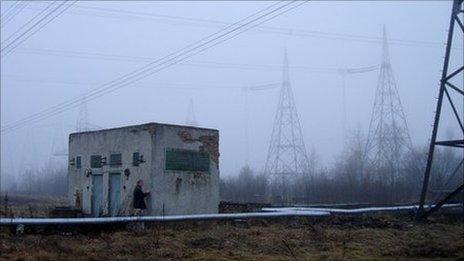Chernobyl species decline linked to DNA
- Published

The scientists have studied the exclusion zone for more than a decade
Scientists working in Chernobyl have found a way to predict which species there are likely to be most severely damaged by radioactive contamination.
The secret to a species' vulnerability, they say, lies in its DNA.
This discovery could reveal which species are most likely to decline or even become extinct in response to other types of environmental stress.
The researchers published their findings in the Journal of Evolutionary Biology.
Professor Tim Mousseau from the University of South Carolina, US, and Dr Anders Moller from the National Centre for Scientific Research in Paris, France, led the study.
The two scientists have been working in Chernobyl for more than a decade, gathering data about the populations of insects, birds and mammals in "zone of alienation" surrounding the desolate nuclear power station.
For this study, they used existing databases to examine in detail the DNA patterns of each of the species they had studied in Chernobyl.
DNA secret
With every generation of a species' lineage, the pattern of its DNA changes ever so slightly, as a result of the natural balance between mutations and the individual's ability to repair damaged DNA. This is how species evolve.
The rate of this change - as each piece of the DNA code is replaced by another - is called the substitution rate.
"This information is available in large database," Professor Mousseau explained to ┤¾¤¾┤½├¢ News. "So you can get the DNA sequences [of each species] and examine the changes that have occurred among a species over time.
Migrating birds have been particularly badly affected by the contamination
"What we have discovered is that when we look at the species in Chernobyl, we can predict, based on their substitution rates, which ones are most vulnerable to contaminants."
Professor Mousseau said that the Chernobyl setting offered a "unique opportunity to look at a natural experiment in progress - [to see] what happens to species when they have this kind of environmental perturbation".
The results of this study could shed light on which species are most vulnerable to other kinds of environmental contamination.
Brightly coloured birds and birds that have a long distance migration were some of the organisms most likely to be affected by contaminants.
"One explanation may be that these species have, for whatever reason, less capable DNA repair mechanisms," said Professor Mousseau.
Dr Louise Johnson, an evolutionary biologist from the University of Reading, said the findings were "fascinating".
"Extreme events like Chernobyl provide opportunities to test predictions about evolution," she told ┤¾¤¾┤½├¢ News.
"One of the difficulties of such research is that it isn't really an experiment- it is impossible to control for all of the confounding variables.
"But [the scientists] have been very careful to test all of the other factors that could be important - antioxidants, population size, body size, etc. of bird species and it appears... that there is a shared causal relationship between accumulating mutations over time and the ability to withstand radiation."
- Published30 July 2010